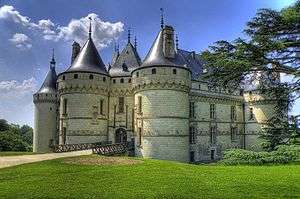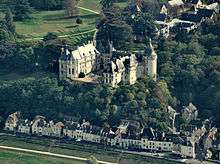Château de Chaumont
The Château de Chaumont (French: [ʃɑto də ʃomɔ̃]; or Château de Chaumont-sur-Loire) is a castle in Chaumont-sur-Loire, Loir-et-Cher, France. The castle was founded in the 10th century by Odo I, Count of Blois. After Pierre d'Amboise rebelled against Louis XI, the king ordered the castle's destruction. Later in the 15th century Château de Chaumont was rebuilt by Charles I d'Amboise. Protected as a monument historique since 1840, the château was given into state ownership in 1938 and is now open to the public.

History

The name Chaumont derives from the French chauve mont, meaning "bald hill".[1] The first castle on this site, situated between Blois and Amboise, was built by Odo I, Count of Blois, in the 10th century, with the purpose of protecting his lands from attacks from his feudal rivals, Fulk Nerra, Count of Anjou.[2] On his behalf the Norman Gelduin received it, improved it and held it as his own. His great-niece Denise de Fougère, having married Sulpice d'Amboise, passed the château into the Amboise family for five centuries.
Pierre d'Amboise unsuccessfully rebelled against King Louis XI and his property was confiscated, and the castle was dismantled on royal order in 1465.[3] It was later rebuilt by Charles I d'Amboise from 1465–1475 and then finished by his son, Charles II d'Amboise de Chaumont from 1498–1510, with help from his uncle, Cardinal Georges d'Amboise; some Renaissance features were to be seen in buildings that retained their overall medieval appearance.
The château was acquired by Catherine de Medici in 1550.[4] There she entertained numerous astrologers, among them Nostradamus. When her husband, Henry II, died in 1559 she forced his mistress, Diane de Poitiers, to accept the Château de Chaumont in exchange for the Château de Chenonceau which Henry had given to de Poitiers.[5] Diane de Poitiers only lived at Chaumont for a short while.
In 1594, at the death of Diane's granddaughter Charlotte de la Marck, the château passed to her husband, Henri de La Tour d'Auvergne, Duke of Bouillon, who sold it to a tax farmer Largentier, who had grown rich on gathering in the salt tax called the gabelle. Largentier eventually being arrested for peculation, the château and the title of sieur de Chaumont passed into a family originating at Lucca, who possessed it until 1667, when it passed by family connections to the seigneurs de Ruffignac.
Paul de Beauvilliers, duc de Beauvilliers and later duc de Saint-Aignan, bought the château in 1699, modernized some of its interiors and decorated it with sufficient grandeur to house the duc d'Anjou on his way to become king of Spain in 1700. His eventual heir was forced to sell Chaumont to pay his debts to a maître des requêtes ordinaire to Louis XV, Monsieur Bertin, who demolished the north wing built by Charles II d'Amboise and the Cardinal d'Amboise, to open the house towards the river view in the modern fashion.
In 1750, Jacques-Donatien Le Ray purchased the castle as a country home where he established a glassmaking and pottery factory. He was considered by the French as a "Father of the American Revolution" because he loved America. However, in 1789, the new French Revolutionary Government seized Le Ray's assets, including his beloved Château de Chaumont.

Madame de Staël acquired the château in 1810. The comte d'Aramon bought the neglected château in 1833, undertook extensive renovations under the architect Jules Potier de la Morandière of Blois, who was later inspector of the works at the château de Blois;[6] M. d'Aramon installed a museum of medieval arts in the "Tour de Catherine de Médicis". By 1851 the "Chaumont suite"[7] of early-16th century Late Gothic tapestries with subjects of country life emblematic of the triumph of Eternity, closely associated with Chaumont and now at the Cleveland Museum of Art, was still hanging in the "Chambre de Catherine de Médicis"; the tapestries had been cut and pieced to fit the room.[8]
The castle has been classified as a Monument historique since 1840 by the French Ministry of Culture.[9] Marie-Charlotte Say, heiress to the Léon Say sugar fortune, acquired Chaumont in 1875. Later that year, she married Amédée de Broglie, who commissioned the luxurious stables in 1877 to designs by Paul-Ernest Sanson, further restored the château under Sanson's direction and replanted the surrounding park in the English naturalistic landscape fashion. She donated Château de Chaumont to the government in 1938.[10] The Château de Chaumont is currently a museum and every year hosts a Garden Festival from April to October where contemporary garden designers display their work in an English-style garden.[11][12]
Gallery
 The chapel
The chapel Stables
Stables The castle seen from the garden
The castle seen from the garden Coat of arms of Louis XII
Coat of arms of Louis XII- The floor of the lounge
 Lounge of Prince de Broglie
Lounge of Prince de Broglie- Château de Chaumont
See also
References
- Blackie, Christina (1968), Geographical etymology: a dictionary of place-names giving their derivations, Gale Research, p. 39
- Hansmann, Wilfried (1986), Loire Valley, Stewart, Tabori & Chang, p. 87, ISBN 9780941434621
- Wheeler, Daniel (1983), The Chateaux of France, Vendome Press, p. 29, ISBN 9780865650367
- Garrett, Martin (2010), The Loire: a Cultural History, Oxford University Press, p. 93, ISBN 9780199768394
- Garrett, Martin (2010), The Loire: a Cultural History, Oxford University Press, pp. 93, 108, ISBN 9780199768394
- Françoise Boudon, "La correspondance de Duban ou les trois humeurs de l'architecte", in Félix Duban: les couleurs de l'architecte, 1798-1870, Bruno Foucart, ed., 2001:9; M. Melot and J. Melet-Sanson, Le Château de Chaumont, 1980.
- Interlaced Cs on the château depicted in the tapestries, with the flaming mountain (chaud mont) emblem of Charles [d'Amboise] de Chaumont strengthen the traditional link with Chaumont (Dorothy G. Shepherd, "Three Tapestries from Chaumont", The Bulletin of the Cleveland Museum of Art 48.7 [September 1961:159-177], p. 165)
- Shepherd 1961:163f; allegory identified, 172ff.
- Monuments historiques: Domaine du château de Chaumont, Ministry of Culture, retrieved 18 May 2012
- Garrett, Martin (2010), The Loire: a Cultural History, Oxford University Press, p. 93, ISBN 9780199768394
- Official website.
- "ArtPremium – A Spring Symphony". ArtPremium. 2017-05-16. Retrieved 2018-05-03.
Further reading
- Bosseboeuf, Louis Auguste (1906), Le Chateau de Chaumont dans l'historie et les arts (in French), A. Mame
